ImagineMe Mannequin Contest 2012
Created in 2010, this mannequin art competition is designed to promote healthy awareness and acceptance of body image. iaedp invites national art therapists from treatment centers and private practice, students and the public to artistically create mannequins that reflect their perception of beauty and body image.
Judging Criteria
Mannequin entries are judged on clarity of theme, creativity and originality, quality of composition and design, and the overall impression and presentation of the artwork. The contest is open to everyone; however, iaedp encourages treatment centers and private practices with art therapists to work with patients to provide entries.
Each year, poster images of the mannequin entries are displayed gallery-style at iaedp’s Annual Symposium. The Winner, Runner-Up, Honorable Mention and Professional’s Choice are awarded during a special ceremony. The winner receives a financial award along with the image of their mannequin being used in Imagine Me Beyond What You See™ promotions throughout the coming year. For the awards ceremony, the winning mannequin is shipped to the Annual Symposium, unveiled along with the artist(s) and later auctioned off with proceeds to benefit the iaedp Foundation.
Video Review
Winner: Shattered
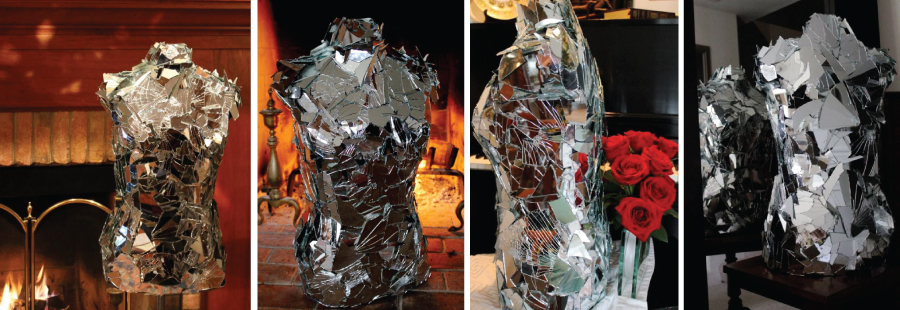
Artist: Dr. Susan J. Mendelsohn’s Eating Disorder Therapy Group
Shattered is a collaborative project created by Dr. Susie Mendelsohn’s eating disorder patients. While the title itself carries multiple meanings, so too does the composition. This piece is the result of several group therapy sessions, during which we shattered mirrors and glued individual shards onto the surface of our mannequin. By destructing these mirrors, we engaged ourselves in a therapeutic process that symbolized both our hatred for this mental illness and the eradication of our own eating disorders. Moreover, we destroyed a tangible instrument that, for us, represents one of the most fueling factors of eating disorders: body image. This process can also signify our deconstruction of institutionalized beauty projected by the media. By gluing the pieces back together in our own arrangement, we subsequently reconstructed our own unique image that does not adhere to the beauty standards valued by society. In this sense, we use mirrors—the very object that has proved so problematic in our past—to empower us.
Visually, the composition depicts different aspects of eating disorders. Upon first glance, the shattered pieces appear as a protective armor covering the entire body. We found this particularly significant because for some individuals, eating disorders may serve as a shield from emotional trauma and the outside world at large. In another sense, the sharp edges of the glass vividly denote the torture and self destruction of eating disorders.
The countless mirror pieces covering the entire mannequin create a refracted sculptural form. But perhaps more importantly, this shattered layer also refracts the viewer’s self reflection. Unable to picture oneself within a realistic perception, the viewer is placed into the shoes of someone who suffers from an eating disorder and, more specifically, body distortion. Just as our obsession with body image can overwhelmingly consume our psyche, the mannequin is visually consumed with mirrors that obstruct the internal substance. With these effects, the composition conceptualizes some of the overwhelming obstacles of eating disorders.
Finally, Shattered also proposes some progressive concepts. The mirror shards prevent the viewer from focusing on the mannequin’s clear-cut shape, and divert the eye in multiple directions away from the body itself. In other words, by diverting the viewer’s attention in multiple directions, we force the viewers to literally “imagine the body beyond what they see.”
In a unique sense, our composition implicates the viewer’s participation and connection, and also offers a self-reflexive abstraction of eating disorder mentality. Furthermore, Shattered unapologetically depicts the uncensored and frightening reality of eating disorders.
Materials:
mirror shards, glue
Artist Profile:
Dr. Susan Mendelsohn is a clinical psychologist specializing in the treatment of eating disorders, disordered eating, body image, relationship counseling and stress management. She currently has a private practice in Cincinnati, OH working with patients from Kentucky, Ohio and Indiana. Prior to moving to Cincinnati in 2003, Dr. Mendelsohn had a private practice in Boca Raton, FL from 1991-2003.
She is a member in good standing of the National Eating Disorders Association (NEDA), the Academy for Eating Disorders (AED) and the International Association of Eating Disorders Professionals Foundation (IAEDP). Dr. Susie provides her clients with a refreshing, peaceful, homey, safe and supportive office environment. No matter what their challenges, her patients are always provided with unconditional positive regard and utmost respect. She gladly collaborates with other experts, providing a multi-faceted treatment approach for each patient as needed. Dr. Mendelsohn has received much praise for her book, “Its Not About the Weight: Attacking Eating Disorders from the Inside out.” In her book she shares her personal struggles with an eating disorder, as well as educating her readers of the psychological complexities of the illness.
Dr. Mendelsohn has devoted her life to the treatment of eating disorders. One of her goals is to promote a greater understanding of eating disorders. To reach a larger audience, her efforts have included informational prime time television commercials which dispel some of the myths that pervade the publics’ understanding of this illness. Dr. Mendelsohn created monthly S.O.A.R. (Sharing Active Ongoing Recovery) Workshops, which are open to everyone who struggles with eating disorders or disordered eating in order to allow greater access to patients and their families. In addition, Dr. Mendelsohn has been conducting a weekly eating disorder process group for eight years, and the current 10 members are responsible for the Shattered mannequin entry. To learn more, visit Dr. Mendelsohn’s website: http://www.transformempowersoar.com
Humanity
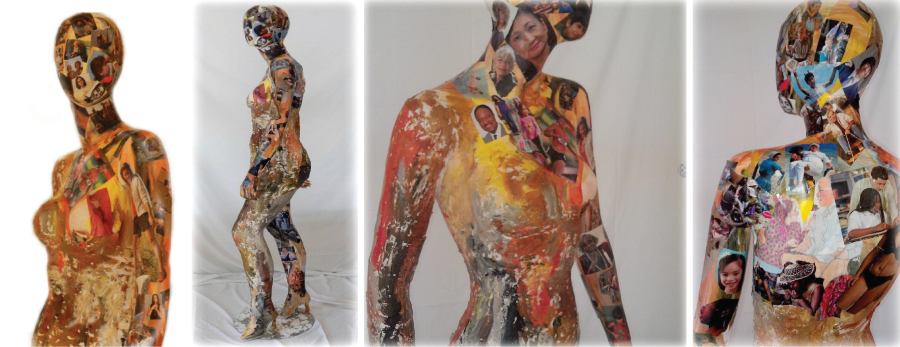
Artist: Carolina House Eating Disorder Treatment in North Carolina, Eva Miller MPS, ATR
“Humanity” was created during weekly art therapy groups at Carolina House. Her creation was inspired by the thought that there is no one definition for beauty.
We started with a blank canvas– a standing mannequin– in the middle of the group room. Her shape and form triggered many thoughts, feelings and discussion. It was decided that the first transformation would be accomplished using plaster to redefine her shape and form. The group used plaster strips, and then transitioned to a bucket of plaster to change her shape. It was a conscious decision to build out only certain parts of her body– one breast is larger than the other, one arm, one leg. The group discussed accepting and celebrating bodies of all kinds.
She was then painted, using many different colors to represent a variety of skin tones. Both the plaster and paint process were hands-on, visceral interactions with the art materials and the human form.
The form served as a canvas for images that were collected and sorted throughout the several weeks this project was created. The group decided to incorporate images of people of all kinds, highlighting activity and relationships. As images were being sorted from various magazines, there was a conscious effort to seek out images beyond the stereotypical posed and airbrushed forms that saturate so many magazines today. The group sought out images representing both men and women, young and old, in many different activities and settings.
During the last group, notes were written both to and from the mannequin as her image and message journeys out into the community.
“Dear Humanity, Thank you for serving as a reminder that our beauty and value lie simply in the fact that we are breathing”…
Materials:
Mannequin, plaster, paint, mod podge, magazine clippings
Artist Profile:
Carolina House, located in Durham NC, is a 12-bed residential eating disorders treatment facility for women 17 and older. Art therapy is an integral component of the multi-disciplinary approach and focuses on using art for healing, growth, and self-expression.
The Onion
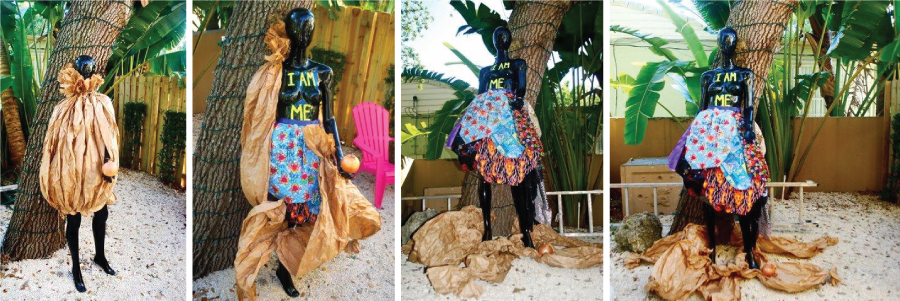
Artist: Casa Rosada – Oliver-Pyatt Centers
Oliver-Pyatt Centers’ Casa Rosada engaged in the project of creating a mannequin to represent the idea Imagine Me Beyond What You See™ during body image groups over the span of approximately three months. Through journaling, discussion, and self-reflection, the group collectively decided to model the mannequin after an onion. To create this, the group participated in a mannequin selection process and thorough discussion of materials and supplies.
The onion theme was created to reflect how people, like onions, are comprised of many layers. Peel away the outer skin and one will find that so much more lies beneath. The onion mannequin is symbolic of the many layers there are to human beings; most beyond what meets the eye.
As part of this project each participating individual was asked to create a “petal” for the onion that portrayed a part of them lying dormant beneath their surface. The petals were attached to the mannequin in layers as a representation of the many different parts of ourselves. Our mannequin reminds us that just like the onion, human beings are more than the surface appearance. We are so much more than what is immediately seen. Across the chest of the mannequin is written: “I Am Me” as a reminder that underneath everything we are all ourselves, each unique in our own ways.
Materials:
Plethora of fabrics, paints, paper and cellophane
Artist Profile:
Participants included residents at Oliver-Pyatt Centers’ Casa Rosada from the beginning of November 2011 through January 2012 during Body Image groups facilitated by Dr. Melissa Orshan Spann.
Ying-Yang/Love-Hate
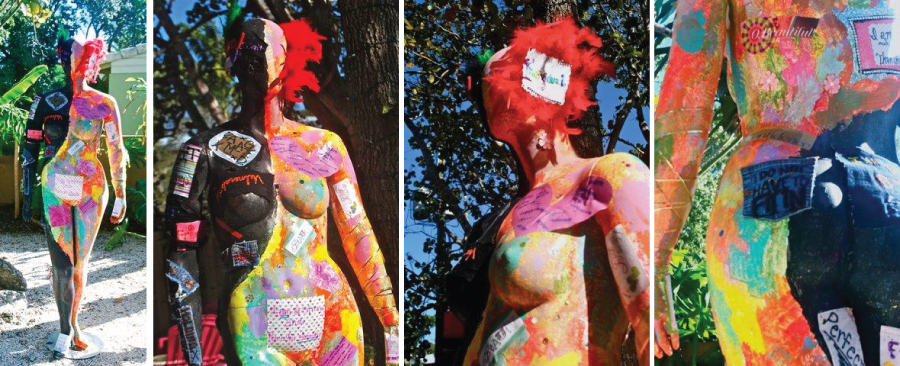
Artist: Women of Casa Verde Oliver-Pyatt Centers
The women of Oliver-Pyatt Centers’ Casa Verde participated in an intensive experience of body image exploration through the Imagine Me Beyond What You See™ project over a period of three months.
After a thorough exploration that included journaling, self-reflection, and group processing, group members decided to have the mannequin reflect both the Ying/Yang and Love/Hate themes that arose when exploring body image.
The actual body shape of the mannequin was chosen from participants to reflect a strong, healthy, and womanly body. The mannequin was detailed painted and constructed to reflect both the dark and light sides that we find within ourselves.
Materials included using a mixture of old “sick” clothes, fabrics, jewels, paint, and paper to represent the self-reflections within each person in addition to layers of paint applied through a sponging and other techniques. The dark side is evident of the pain and self-hate that participants experience while the colorful side represents the hope, strength, and power within each of us. Through the words and symbols placed upon her, participants displayed how although struggles with body image may occur, the reflection of affirmations and hope move them closer towards recovery.
Materials:
Mixture of old “sick” clothes, fabrics, jewels, paint, and paper
Artist Profile:
Participants included residents at Oliver-Pyatt Centers’ Casa Verde from the beginning of November 2011 through January 2012 during Body Image groups facilitated by Dr. Melissa Orshan Spann.
The Light Within
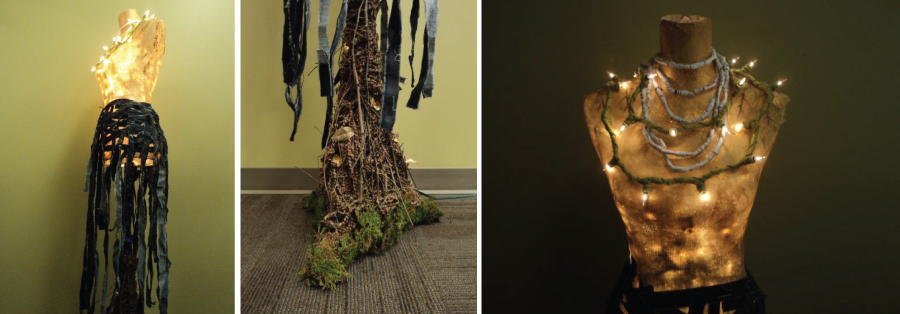
Artist: Eating Recovery Center’s Behavioral Hospital for Children and Adolescents / Katie Pruitt, ATR-BC
A group from Eating Recovery Center’s Behavioral Hospital for Children and Adolescents worked on the body image project for Imagine Me Beyond What You See™. The project was facilitated by the unit’s art therapist Katie Pruitt. The main message that the group wanted to convey was being seen for who they are as a person on the inside, rather than for their eating disorder. This is why they decided to light their mannequin up from within. The group discussed how part of the recovery process is rediscovering one’s sense of self and coming to life again which is also symbolized by the use of light on the outside of the mannequin.
Around her neck she is wearing handmade paper bead necklaces. The beads are made out of copies of pages from group member’s journals. Many of them use journaling and poetry writing as a way to cope with the difficult feelings and emotions that arise during the recovery process. The group felt it was important that their mannequin wear these necklaces as a representation of what she has been through and the strength that comes with the knowledge that she has overcome something so difficult. There are five necklaces one for each group member that participated.
The strips of denim around her torso came from a pair of jeans. The group painted and wrote numbers on the jeans. They discussed how clothes, and particularly jeans, could be something that strengthened the eating disorder and worked against their recovery. They described the transformative process of ripping the jeans and creating something new from them as liberating.
At the base of their mannequin are her roots symbolized by the weaving of yarn. Knitting is another popular coping skill on the unit and the group wanted to incorporate that into their image. She is now re-grounded in her sense of self and ready as the group members said, “To enjoy life!”
Materials:
Paint, jeans, lights, yarn, paper, collage materials (glue, leaves, twigs and moss)
Artist Profile:
Katie Pruitt, ATR-BC, is a registered, board certified art therapist. She has been working in the field of eating disorders for the past five years. She is particularly interested in body image issues and utilizing the artistic process as a positive therapeutic outlet.
Mariposa (Butterfly)
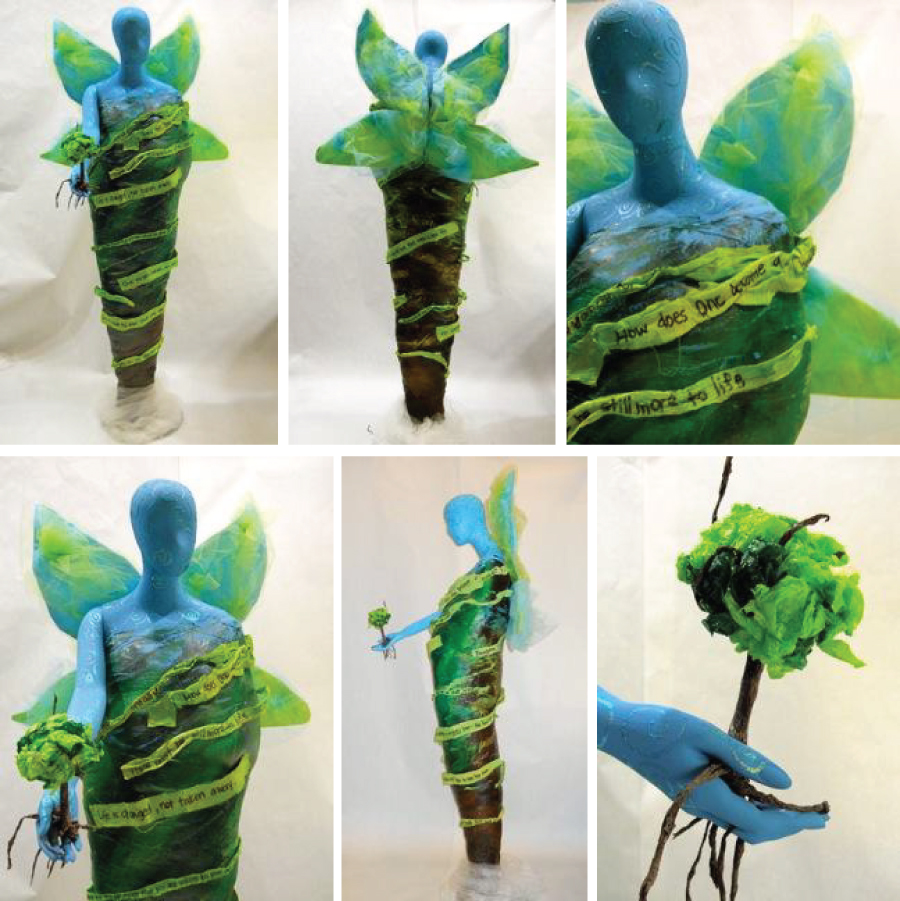
Artist: Eating Recovery Center’s Partial Hospital Program / Lisa Talucci, MA, LPC, ATR
Eating Recovery Center’s Partial Hospital Program created our 2012 Imagine Me Beyond What You See artwork entry. A book called Hope For the Flowers, a story about 2 caterpillars in search of a meaningful life, inspired the artwork. Its first attempts at finding a valued life took them climbing to a superficial existence, following the masses. True transformation could only take place after they were willing to be in the unknown place of incubation in a cocoon, where real change takes place. The journey of the butterfly is mirrored in the treatment of eating disorders.
Our group named the figure Mariposa, Spanish for butterfly. She is wrapped in a cocoon, as a symbol of incubation and the process of transformation into a greater experience of life. The cocoon can also represent the ways in which we can restrict ourselves internally with rules, emotional avoidance and inflexibility. As part of the cocoon, she is wrapped with silky threads impressed with passages from the book. The cocoon is painted brown at the bottom, symbolizing earth and graduates to green and blue, representing the sky. Mariposa herself is blue with sparkling spirals painted on her as a pattern symbolizing transformation. The wings symbolize a life with increased freedom, potentials and possibilities. She holds the tree of life with a single white dove resting in the branches.
The following are passages from the book integrated as ribbons wrapping the cocoon:
There must be still more to life
How does one become a butterfly?
It looks like you will die but, really you will live
You must want to fly so much that you are willing to give up being a caterpillar
Life is changed, not taken away
Once you are a butterfly, you can really love, the kind of love that makes a new life
A cocoon is an in between house where change takes place
For courage, she hung right beside the other cocoon and began to spin her own
Imagine, I didn’t even know that I could do this!
You’ll be a beautiful butterfly – we are all waiting for you
Materials:
Mannequin, craft paper, tissue paper, gauze, burlap and netting fabric, batting, acrylic paint, modge podge, fabric stiffener, wire, tape, spray glue, glitter glue pen, sharpie
Creative Process:
Each group meeting consisted of a different constellation of people and twelve artists contributed to this work. Once we established the concept, we wrapped the figure in batting, gauze and strips of burlap. Gauze strips were shaped into ribbons with fabric stiffener and painted. The figure was painted in several stages. The wings were constructed from craft paper, tissue paper and fabric netting. Tree of Life was constructed from tissue paper and glue. The bottom of the figure is wrapped in white netting that begins the representation of the cocoon.
As the project was being constructed, people discussed the challenges of recovery at the partial hospital level as well as their progress. As a group, they became aware of how they participate in the process of community, cooperation and consensus. It was not always easy, but a complete image and story came together with each person contributing their unique part of a whole. This is quite an accomplishment for people with eating disorders to let go of isolation while in treatment and become part of the whole. Our hope is that people can take this connectedness into their life and community at large.
Artist Profile:
Lisa Talucci, MA, LPC, ATR is a Licensed Professional Counselor and Registered Art Therapist who has 20 years of clinical experience working with children, adolescents, adults, families and groups. As an Expressive Art Therapist she uses art, movement, role play, writing and sand play. She has developed intermodal programs and curriculums including Children’s Bereavement Program for Hospice, Adopted Children and Families for Hope Worldwide, chemotherapy patients for Rocky Mountain Cancer Center, 3 partial hospital programs, Violence Prevention for Boston Public Schools, foster children in residential care, and consultant to Department of Social Services. Lisa has worked at the Eating Recovery Center since it’s opening in 2008 as a primary therapist and art therapist, integrating ACT and art therapy. She has served as Vice President of the Art Therapy Association of Colorado.
Tree of Life
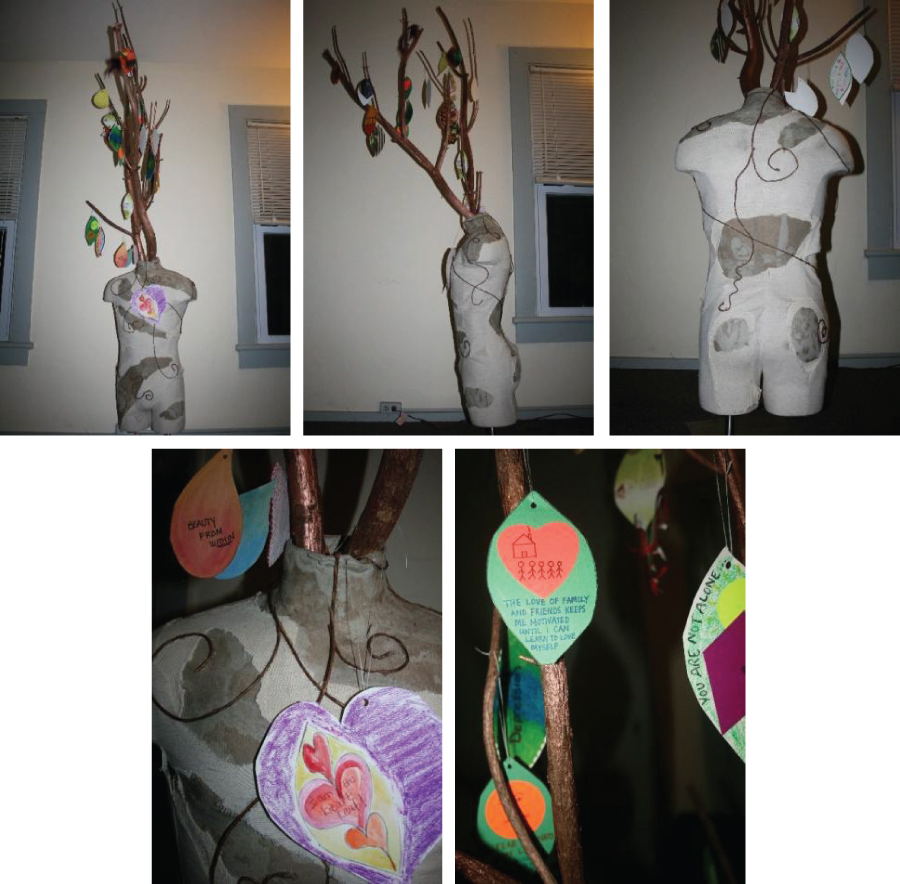
Artist: Nutrition Clinic’s Intensive Outpatient Programs and Sol Stone Partial Hospitalization Program
The dimensions are 6’7″ tall, 3′ wide. Genevieve Skillen, art therapist and IOP coordinator, brought the mannequin to each of the IOP art therapy groups, with its final destination at the Sol Stone Center.
The initial response from clients in the first group was to transform the mannequin into a tree symbolizing the life connection of all members. Each group member then created a leaf representing their own individual struggles with their self awareness/self acceptance. As the mannequin travelled to each program site, group members continued to transform the tree with their own “leaves”, their own internal struggles with self judgment.
A universal theme heard in each group was that negative body image is the final and most challenging aspect of one’s judgmental part to release. However, as one discharging client stated, body acceptance is a significant part of the process of recovery and Self acceptance.
Materials:
tree branches, paper, feathers, and twine
Artist Profile:
Multi-group effort on the part of clients attending The Nutrition Clinic’s Intensive Outpatient Programs in Syracuse, Ithaca, and Binghamton, NY, as well as the Sol Stone Partial Hospitalization Program located in Elmira, NY. Under the guidance of Program Director Clare Brown of the Sol Stone Center partial hospitalization program for eating disorders and Art Therapist Genevieve Skillen.
Unraveled

Artist: Rebecca Tishman
Unraveled serves as a visual representation of the overflowing beauty within each of us. I created Unraveled from only thread, buttons, and glue in hopes of creating an illusion in which the viewer was not immediately aware of the presence of the materials I used. The thread covered buttons spilling out from the neck of the mannequin and winding around the body show the overflowing beauty we each contain whether that beauty is present right on the surface or rising from the deepest places hidden within us but nonetheless present in each of us in one way or another. From the side the layers resemble a cross-section, giving the impression that the viewer can see through to the inside of the form, which is glowing red. The piece highlights illusions and distortions we face regarding our bodies and internal feelings.
Materials:
Mannequin, thread, buttons, glue
Artist Profile:
I am a sophomore Interdisciplinary Sculpture major at Maryland Institute College of Art. I draw on my personal struggles with body image and eating disorders to create pieces that can hopefully reach a wide audience and give a voice to those who, as of yet, are unable to explain to others the struggles within themselves and to inform those who are unaware of the struggles one faces with an eating disorder.
As a result of my affinity for everyday objects in modern Western culture, much of my work is based on these mass-produced, household objects that I collect in large quantities. I glue, sew, caulk, bend, and weave silverware, nails, and buttons until the objects are stripped of their original function in society and transformed into something entirely different. Within these transformations the objects now serve as part of a whole rather than retaining their independence as individual objects. To make the work the size I intend requires a serious time commitment, thus juxtaposing these modern Western objects with patience and an attention to detail that is not typically Western. The pieces begin from hundreds of separate objects that I manipulate to remove their usual identity to serve as part of a greater whole. Generally, I can restore them to their original identity as an independent object, calling attention to the futility and temporality of the repetitive tasks I perform to create the works.
Skin Deep
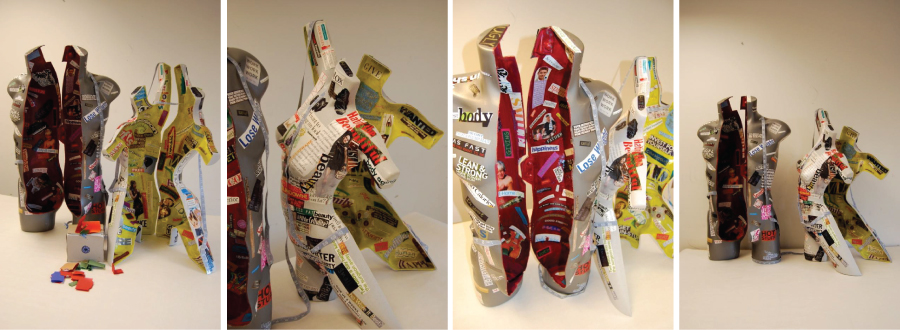
Artist: Reflections Eating Disorder Treatment Center at Dominion Hospital Amy Greenough, Art Therapist and Felicia Kolodner, Program Director
Each week ten members of the combined inpatient and outpatient milieu would attend the hour and a half group. The goal for this group was to foster a therapeutic space and activity that promoted positive concepts of body image. Through the collaborative efforts of the individuals we used mannequin as a canvas for our thoughts, feelings, and ideas about body image.
Each group began with, “checking our baggage.” Small suitcases from construction paper were provided for people to use as a container to write about anything that was on his or her mind at that moment. We did not share or discuss these things, but rather used this time as a way to become aware of anything that might prevent us from not being present in the group. We put “locks” on our luggage with fun stickers, and placed them inside a “safe-box”, and set it by the exit door. This became a small, but essential start for transitioning into our work.
After our brief check-in, and a quick summary of the previous discussions, we would begin. In one of the first groups, before mannequins were introduced, patients were asked to, “create a piece of artwork that shows an outward part of yourself, which represents an inside personality trait.” This directive became a great foundation for positivity and curiosity for this group. Rather than focusing on the physical body parts, we were able to engage in conversation regarding our character strengths. One individual said, “I never thought about body image in this way before.”
Gender became the first topic that participants had strong feelings towards, and decided that a “gender neutral” mannequin would be best. It was discovered quickly that such a thing is not easy to find. So, we chose one of each gender, knowing that this piece was ours to manipulate as necessary. We now have two separate pieces treated with the same process, tied together by their mutual struggle to free themselves from judgment. Through this, one essential message that the group would like to convey is that eating disorders impact each gender.
The piece that you see photographed represents the essence of our therapeutic process. We have constructed on the outside of our person-canvases negative messages from the world (from magazines), or that the group members themselves have subscribed to (hand written). One individual reports, “It was a lot easier to find negative words for body image rather than positive affirmations.” Through creating a focus on the internal, group members may have had the opportunity to successfully practice identifying and focusing on positive attributes. Some were able to find empowerment through this process. One individual reported, “…I know that society is WRONG.” Another member of the group discovered that she was able to enjoy the process, “even if it was tough to deal with some emotions and thoughts.” This piece shows the group has learned, “beauty is from the inside out.” Through the creative process, “we supported each other with this endeavor and were able to find that delicate balance of body image within ourselves. There is nothing more beautiful.
Materials:
Mannequin with mod podge, magazine clippings, decorative paper, glitter, metallic pens, acrylic paint, measuring tapes, and brass hinges
Artist Profile:
The Reflections Unit at Dominion hospital offers hope to adolescents and adults with eating disorders on both an inpatient and outpatient basis. Patients receive assistance from a multi-disciplinary team as they tackle, and overcome their eating disorders. This group was conducted with the goal in mind to foster positive interaction with body image through a group art making project.
Blossoming Into Wholeness
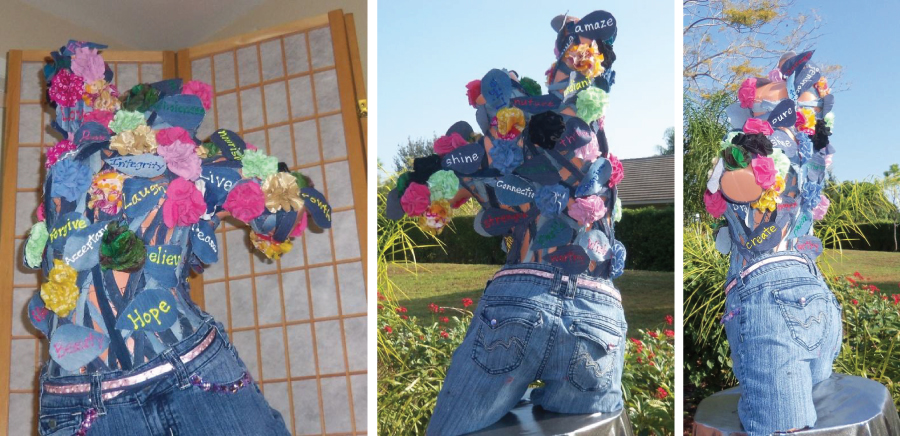
Artist: Residents and Alumni of The Renfrew Center of Florida
Her design came into being from recycled clothing that was once worn by the residents and alums of our program. As the residents and alums grew emotionally, they were able to heal from the inside out; therefore, making it possible for them to surrender their “unhealthy clothes.” Giving up the unhealthy clothes is very symbolic to someone who suffers from an eating disorder. If it were not for the healing that took place among the residents and alumni, we would not have been able to complete this creative project. The healing has allowed each of us to blossom into wholeness. Our mannequin is a representation of that healing.
The intertwined vines represent the complex pathways from which seeds can grow and blossom into whole flowers. Each flower is diverse in its size and shape and is alive and vibrant with color. The leaves serve as support holding messages to inspire growth along the pathway to transformation. Inherent in the message is the belief that there is power in community and strength in the compassion that flows throughout a group of people who all share one wish: to walk hand in hand on the journey of becoming whole!
Materials:
Mannequin, Recycled clothes, Glue Sticks, Gun Ribbon, Jemmed buttons, Tulip Paint
Artist Profile:
The Renfrew Center is the country’s first and largest residential eating disorder treatment network and has treated more than 60,000 women since 1985. Renfrew provides a comprehensive range of services throughout the nation, including: Residential, Day Treatment, Intensive Outpatient, Psychiatric Consultation and Nutrition, Group, Individual, Family and Couples Therapy. Renfrew is a preferred provider for most health insurance and managed care companies and works with individuals to create a financial plan that meets their needs. www.renfrewcenter.com
Bella

Artist: Rogers Memorial Hospital/ Tina Szada, ATR-BC
The mannequin represents the struggle of body image with eating disorder patients from the perception of the therapist. The body is created pure from the beginning, but this can change by an eating disorder growing as well as the reflection of society on body image. The eating disorder can start as a beautiful flower but the underlying idea is that the flowers are very dark, thorny and dead. The eating disorder can grow into this cloak that is draped over the body. It becomes this weight that continuously makes the person think and feel that they have to be perfect and focus their life on numbers. This creates the feeling of uncomfortableness in their body.
The whole piece may look glamorous, but the body will never feel comfortable with an eating disorder because it will always be there giving negative feedback to the body. In treatment, therapists are helping patients to take a look at how the cloak was created and work through the conflicts this has created in their life. Also helping patients to take off the cloak that burdens them and helping to challenge those negative thoughts and replace with affirming
Materials:
Mannequin, Spray paint, Tissue paper, Gesso, Beads, Iron-on transfers, Sheer material, Artificial flowers, Mirror pieces, Acrylic paints, Wire, Glitter glue
Artist Profile:
Tina Szada, MS ATR-BC, is the art therapist at the Eating Disorder Center at Rogers Memorial Hospital. She has been working in healthcare for 15 years and has varied experiences. Tina has worked with clients with cognitive, developmental and physical disabilities in a wide range of age groups from older adults to adults to adolescents to children. Over the last 6 years her work has focused on self-concept, emotional regulation and body image. Currently she works with adolescents and adults, men and women, currently in the residential level of care. The clinical approach she uses is studio art therapy, in the sense that there is an intention that the client creates which is then transformed into an art form. In the studio the focus is put upon the process of the art-making. Tina uses body image drawings as a way to deal with distortions and dissatisfaction that people have with their bodies as well as utilizing body traces to explore the origins of their body distortions and help promote a more loving way towards their bodies. The artwork reinforces that people are much more than their bodies.
She is a Tree

Artist: Sara Burchfiel
My vision for this project was to transform a mannequin into a tree. The natural world has always been a source of grounding and healing for me. At one point during my treatment, my therapist compared trees to women – we look at trees and see only beauty. We don’t criticize broken branches, seared trunks, and brown leaves. We don’t compare or call one ugly because it looks different than the next. No, we see their magnificence. So, why do we look at ourselves so differently? Why do we judge and compare and degrade our body when we would never do that to a tree. I was awed! I later heard this same idea in Daryl Robert’s documentary, “America the Beautiful I” and while working on this project I was delighted to discover that one of my favorite writers, Clarissa Pinkola Estes, uses this same metaphor in her fireside chat – The Joyous Body. My hope was that the finished project would speak to this concept and challenge our definition of beauty.
Her Journey to Life
Shoreline Center for Eating Disorder Treatment sponsored the purchase of the mannequin. I found her “used and damaged” on Craig’s List – I thought to myself, “All the better – what woman does not carry with her scars of some sort?” I was shocked when I arrived to the warehouse – the mannequin stood at 5’9 and per the manufacturer; her measurements were 32-25-34. It was clear that weight restoration was the first step towards life. A few of my friends from the Alumni group helped with this process – her new measurements are now approximately 36-31-41. For the next 5 months, she planted herself in my studio apartment and grew roots.
After restoring her weight, I paper mached the mannequin with pictures of women from a wide range of age, culture, fashion, and size. I even included a picture of myself near her bosom. Adding a layer of brown paint over the pictures was an internal challenge, but became cathartic. I did not want to cover their beauty – their personality – but I knew that I needed to take the plunge for my mannequin to become a tree trunk. Section by section, I covered her body in a layer of brown paint and followed by wiping it away with a wet cloth. This allowed the images to show through while maintaining a brown tint. As I gently wiped away the paint, I felt like I was caring for each woman. It became symbolic and spoke to the very nature of my project – Our beauty has been muddled and lost in an unattainable quest for “perfection” (whatever that is), and here I was, washing that away and revealing beauty in the idiosyncrasies. I used actual branches from a tree at Satori (Shoreline’s extended care house) to create her limbs. This feels sacred to me as Satori shares in the energy and message of my project and is where I discovered so much healing.
I created a questionnaire and asked friends, colleagues, former classmates, and girls I had been through treatment with to complete. I also gathered a few “letters to my body” from blogs on the internet. The responses were by far the most impacting for me during this process. I was honored that people were willing to respond so honestly to the questions and share with me their inner feelings, insecurities, as well as their stories of reconciliation and acceptance of self. Some responses brought tears to my eyes because of the self-hate and shame. I see these women as gorgeous and soulful – it is heartbreaking that they cannot see this themselves. Some responses made me giggle. Some made me smile at the peace and joy discovered. The wide range of responses spoke loudly to the complexity of our relationship with our bodies. I was fascinated because when asked to define “beautiful” very few women spoke of physical beauty, they instead talked about character or an inner-felt, often spiritual experience. Yet when asked if they view their bodies with this same definition, most answers were a resounding “No.” One’s body beauty was almost always related to weight and body size. When asked a time that they felt comfortable in their body – interestingly many women said “same answer as a time that I felt beautiful.” Does this mean that “beauty” has become a synonym for “comfort” when thinking of our bodies? Can a woman only feel comfortable if she meets a criteria that is not even congruent with her definition of beauty on a whole? It feels very sad. Not surprising to me, ALL of the women who had found peace and were able to appreciate their unique body began to look inward – their definition of beautiful was aligned with their body concept and removed from physical ideals. Not a single woman who was at peace with her body attributed it to weight or size. Not one.
I wanted the leaves to be as unique as each woman – so not a single leaf is the same. It felt dishonoring to use stagnant colors and a leaf template to hold the sacred words of these women. While I did use a general template – I opted to burn the edges of each and every leaf – this gave each one its own shape as well as speaks to the scars that we all carry.
She is a Tree of Life.
Materials:
Mannequin, Bubble Wrap (“weight restoration”), Masking Tape, Liquid Starch, Newspaper scraps (for paper mache), Images of Women from gathered from magazines and a photography book titled: 6 Billion Others Portraits of Humanity from Around the World, Brown, green, yellow, orange, and red acrylic paint (in various shades), Spray bottle, paint brushes, sponge, washcloths, Self created Questionnaire and responses, Spray Varnish, Super glue, Thread (to secure leaves to branches), 6 Inch nails (to secure branches to body), tree branches, Leaf templates, stones (for base), fake moss (for base), BBQ Lighter (to burn leaf edges), Lamination machine (for leaves)
Artist Profile:
I went through treatment for my eating disorder at Shoreline Center for Eating Disorder Treatment from 2006-2008 – this consisted of participating in the partial hospitalization program, intensive outpatient program, and I stayed at Satori (Shoreline’s extended care facility). Since then, I have continued in individual therapy at Shoreline and participate in the alumni group. Recovering from an eating disorder was one of the most difficult journeys I have embarked, but it has also been most rewarding. I am beyond grateful to have discovered healing, life, and hope. I graduated with a master’s degree in Clinical Psychology in May of 2011 and my goal is to work with those affected by eating disorders.
Additional Information:
Questionnaire responses provided by Sara Burchfiel:
Dear Body,
Please forgive me for discarding you and letting you go, pushing copious amounts of food down your throat in an effort to control parts of my life where I had no control. I’m so sorry I’ve hurt you.
I define beauty as Self-love toward my body, mind and soul. When it comes to my body, beauty is having good health. When it comes to my mind, it is when I am able to love my unique side. I stop feeling like an alien and I feel like I am a unicorn. When it comes to my soul it is when I let it express through art.
Do you use this definition when thinking about your body?
Yes. When I think about my body, I think about my health and my organs. And when I think about my organs, I think of the beauty of their function. My body does so much for me every day. So I treat my body like a stubborn child and I am its parent. I nurture it every day. This is the act of self-love in my definition.
I feel like only skinny girls can talk about body image. The girls who are beautiful and popular – they can talk about body image. I’m fat. Aren’t I supposed to have a bad body image? If I said that I loved my body, people would look at me like I’m crazy. They would feel the need to give me a reality check that the extra weight isn’t healthy. If I say that I have bad body image, they say, “do something about it, eat healthy, lose weight, exercise.” I just want to scream, “god damnit, I know all that.” How am I supposed to have good body image when our society talks of the “obesity epidemic” and fat jokes are accepted as funny? How am I supposed to feel good about myself.
when people think that I’m fat because I don’t have “self control” or “willpower” or eat junk food all the time….that’s not true….i have will power, I have self-control, I work hard, i’m just fat. I don’t think I eat that differently than the skinny girl next to me. Body image is a skinny girl problem…fat girls like me…..people think we have a problem if we DON’T have a bad body image.
I can remember talking with a good friend about beauty our freshman year of high school and i have continued to believe what we said. We talked about a woman’s beauty being something that is earned by her. That there is beauty in accepting who you are, taking care of yourself, being able to engage in who and what is around you fully, and to hold yourself with poise. We talked about the difference between someone who is pretty on the outside, but is nothing compared to a beautiful old woman…beauty is a look in an old woman’s eyes, it is not something easily defined.
A time that I felt beautiful was when someone told me my words were capable of changing lives. It was the importance of it that felt beautiful. It forced me to see that all of me, my body included, was powerful, real, stunning.
I define beauty as a feeling of inner vibrancy.
Do you use this definition when thinking about your body?
No; definitely NOT about my body. I use this definition when I feel inspired, content, seeing something in nature that is breath-taking. Watching a hummingbird…connecting with people.





